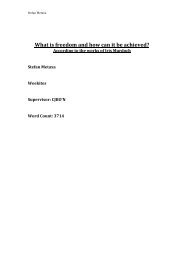Oliver Sheridan-Methven | PDF - Charterhouse
Oliver Sheridan-Methven | PDF - Charterhouse
Oliver Sheridan-Methven | PDF - Charterhouse
You also want an ePaper? Increase the reach of your titles
YUMPU automatically turns print PDFs into web optimized ePapers that Google loves.
<strong>Oliver</strong> <strong>Sheridan</strong>-<strong>Methven</strong> Chaos Supervisor - DL<br />
Pageites Word Count - 6460<br />
Figure3<br />
Strange Attractors<br />
Figure3 shows how the measurements of a system and how it is behaving over<br />
time (top row); e.g. velocity with time, translate into phase space diagrams (bottom row)<br />
of height with gradient. Here it is evident that where the top row may be unclear in<br />
displaying how the system is behaving and what it will do with time (most prominent in<br />
the top right plot), when transformed into a phase space diagram it can become<br />
apparent what the system is doing. Thus apparent randomness, in what appears to be a<br />
chaotic system, can be translated into predictability in phase space, allowing for a<br />
chaotic system to be made predictable [1,3].<br />
The idea of there being underlying patterns in phase<br />
space which produce predictability, seems counterintuitive for<br />
chaotic systems. The fact that "randomness" can have patterns<br />
seems slightly illogical (and to an extent impossible) and thus<br />
an experiment was conducted to try to demonstrate this<br />
concept with real data collected from the lab, and not<br />
produced from theory. A very basic system encountered<br />
which was unexpectedly chaotic was that of the pendulum.<br />
For an equivalent James Gleick used the image of a child on a<br />
swing, which will be extended upon in the explanation of the<br />
experiment.<br />
If a child is on a swing and the swing is not moving<br />
then as time goes by the child will stay on the swing in the<br />
same position, which is obvious. If a child is then pushed once<br />
in the swing then they will oscillate to and from the same<br />
height, just at different angles on the swing (demonstrating the<br />
conservation of energy). Finally if friction is acknowledged then<br />
eventually the energy will dissipate from the system and the<br />
child will eventually come to a halt in the bottom of the swing<br />
position again. When these three processes are plotted in<br />
phase space (Figure4) it is much clearer to see the behaviour<br />
of the system and to spot the strange attractors in the system.<br />
NB even though the system is not yet chaotic, it has strange<br />
attractors in phase space [2].<br />
In the frictionless system the swing will carry on<br />
swinging and the phase space will form a loop (Fiugre4) which<br />
Strange Attractors<br />
Figure4<br />
Page 5 of 18
















